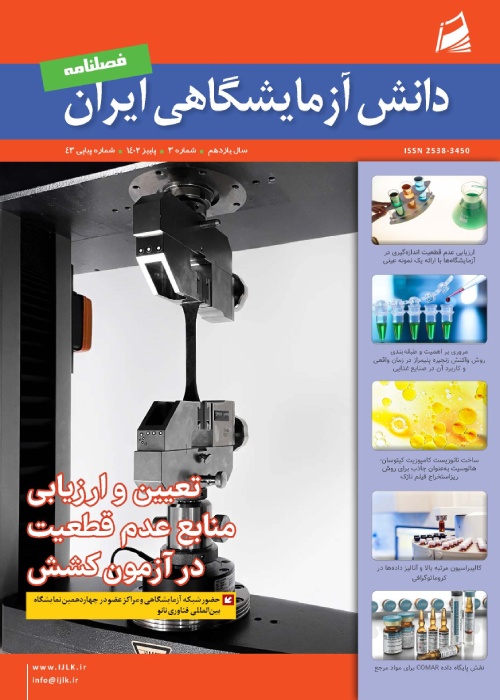فهرست مطالب
مجله دانش آزمایشگاهی ایران
سال هشتم شماره 4 (پیاپی 32، زمستان 1399)
- تاریخ انتشار: 1400/01/24
- تعداد عناوین: 9
- اخبار
- استاندارد
- مقالات
-
صفحات 11-16
-
صفحات 41-54
-
Pages 5-10
Inter laboratory comparisons and Proficiency Testing are one of the most important elements of ISO/IEC 17025 standard. According to this standard, An Independent and regular assessment of the laboratory's technical performance is necessary to ensure the validity of the results And it should be considered as part of the laboratory quality strategy. Inter laboratory comparisons give the chance to laboratories not only will it validate its laboratory results, but also monitors its laboratory system and identify systematic errors and resolve them which leads to the trust of customers and their durability in the labor market. On the other hand, using inter laboratory comparisons, precision, accuracy and repeatability of data and test method are examined. And also, using it, we can compare new methods with approved methods and validate it.
Keywords: Inter Laboratory Comparisons, Proficiency Testing, Laboratories, Accreditation -
Pages 11-16
High-throughput experimentation (HTE) or High-throughput screening (HTS) is revolutionary method in the pharmaceutical, biological and chemical industries, especially in the field of pharmacy, has enabled the rapid screening of large-volume hybrid libraries for various therapeutic research purposes. The past decade has also witnessed the extension of HTS principles toward the realm of small-molecule process chemistry. Today, most major pharmaceutical, biological and chemical companies have created dedicated HTE Systems. In the study, the test method is introduced and the implementation of the method its application, future perspective and horizon, required infrastructure and facilities will be discussed. Some Examples of implementation methods will also be introduced.
Keywords: HTS, HTE, High-throughput screening, screening, Assay -
Pages 17-26
Single-electron transistors (SETs) are one of the most basic single electron tools and have received much attention in the field of nanoelectronics. These types of transistors have very low consumption power, high performance speed, low conductivity losses, good controllability and the ability to miniyator to nanometer dimensions. A single electron transistor is a nanometer switching device that controls the movement of electrons. Due to their scope of working and in order to useing this type of transistor at ambient temperature with a minimum of Coulomb oscillations, makeing of this type of transistor with small quantum islands is very important. Nowdays, with the useing of scanning tunneling microscopes (STM) and atomic force microscopy (AFM), it is possible to makeing these types of transistors with islands in the range of a few nanometers with stable Coulomb oscillations at room temperature. In this paper, the basis of the working of single electron transistor and different methods of using scanning probe microscopes in their construction will be investigated.
Keywords: microscope, Single electron transistor (SET), nano oxidation process, Coulomb gap, Coulombstaircase, Coulomb oscillations -
Pages 27-32
Due to the fact that vegetables and summer vegetables have the ability to absorb large amounts of nitrite and nitrate, so the consumption of such products by humans can endanger health. The aim of this study was to provide an effective method for measuring the amount of nitrate and nitrite in vegetables and their products in ppm using a spectrophotometer. In this method, by removing the disturbances by chemical precipitation method and using dye development reagents and creating a color complex in the extract, and finally reading the amount of color complex adsorption created by the device, the amount of nitrate and nitrite in ppm is obtained. This article is just a test method that has been validated in test laboratories.
Keywords: Spectrophotometer, Nitritemeasurement, Nitrate measurement, Molecular intermediation -
Pages 33-40
In this study, the evaluation quality of metal samples internal defects in conventional ultrasonic methods, fuzzy array and full focus method were compared. The UT method met the basic needs in the evaluation of defects, but due to the variety of defects, PAUT and TFM methods were successfully introduced. TFM evaluation has significantly improved the performance of ultrasonic defects. Gekko M2M device was used to compare the quality of the mentioned methods. This device has the ability to compare and evaluate defects with ultrasonic methods, fuzzy arrays, diffraction flight time and full focus method separately. According to ASTM E2491 standard, samples with specific defects and different sizes and distances from each other were prepared and the evaluation of these defects was performed separately by the mentioned methods in order to identify, measure and compares them. The results show that the ultrasonic method represents the defects with smaller size that are placed next to each other as a single defect. The fuzzy array method has the ability to distinguish these defects from each other, but the flight time diffraction method measures, examines and detects the type of defects with high accuracy. We will also cover industrial cases to demonstrate the benefits of the full focus method
Keywords: Advanced inspection, corrosion, welding, ultrasonic, UT, PAUT, TFM -
Pages 41-54
Contact angle is the best criteria for evaluating the wettability and surface energy. Accurate measurement of contact angle enebales the coating and paint manufactures to produce paints with diverse wettability, adhesion and durability. Numerous methods have been utilized for measuring the contact angle, where each has its pros and cons. Based on the materials being tested and expectation of researchers, the suitable method must be selected. In this study, methods for measuring contact angle have been introduced and advances in these methods are investigated. This paper educates the researchers to choose the best technique for measuring the contact angle and achieve acceptable and reliable results.
Keywords: Contact angle, sessile drop, water, liquid, Surface energy


